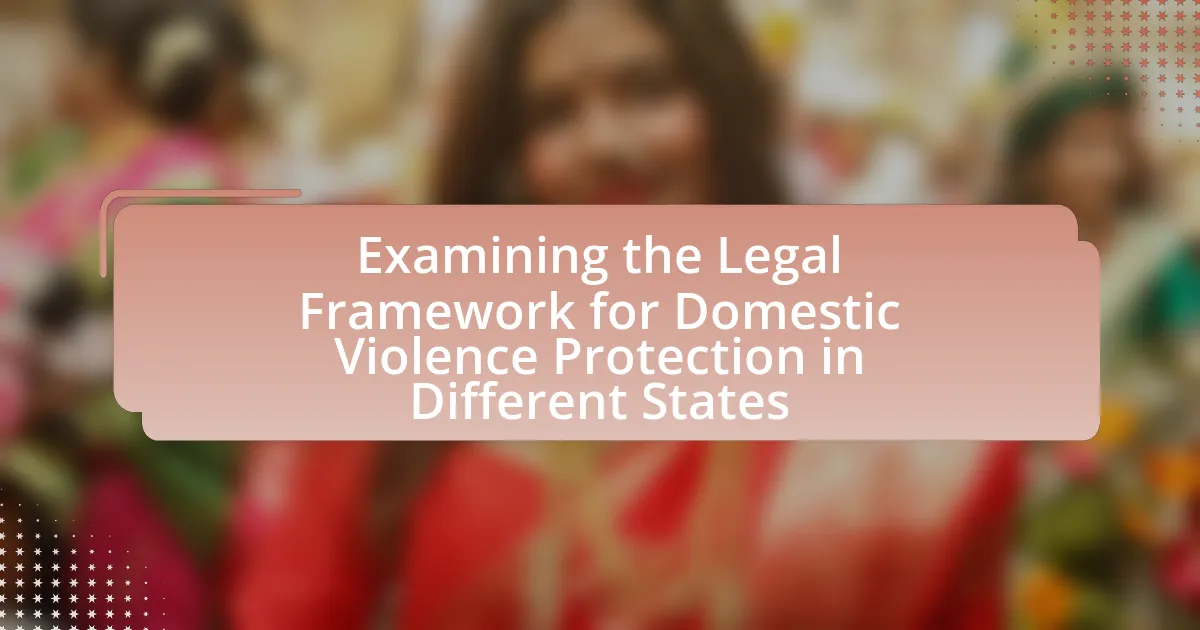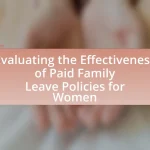The article examines the legal framework for domestic violence protection across different states in the United States, highlighting the various laws and regulations designed to prevent and address domestic violence incidents. It discusses key federal laws, such as the Violence Against Women Act (VAWA), and outlines how state definitions of domestic violence vary, including the types of protective orders available and the criteria for obtaining them. The article also addresses the challenges victims face in accessing legal protections, the role of law enforcement, and the effectiveness of current laws, while suggesting best practices and legislative changes to enhance domestic violence protections and support services for victims.
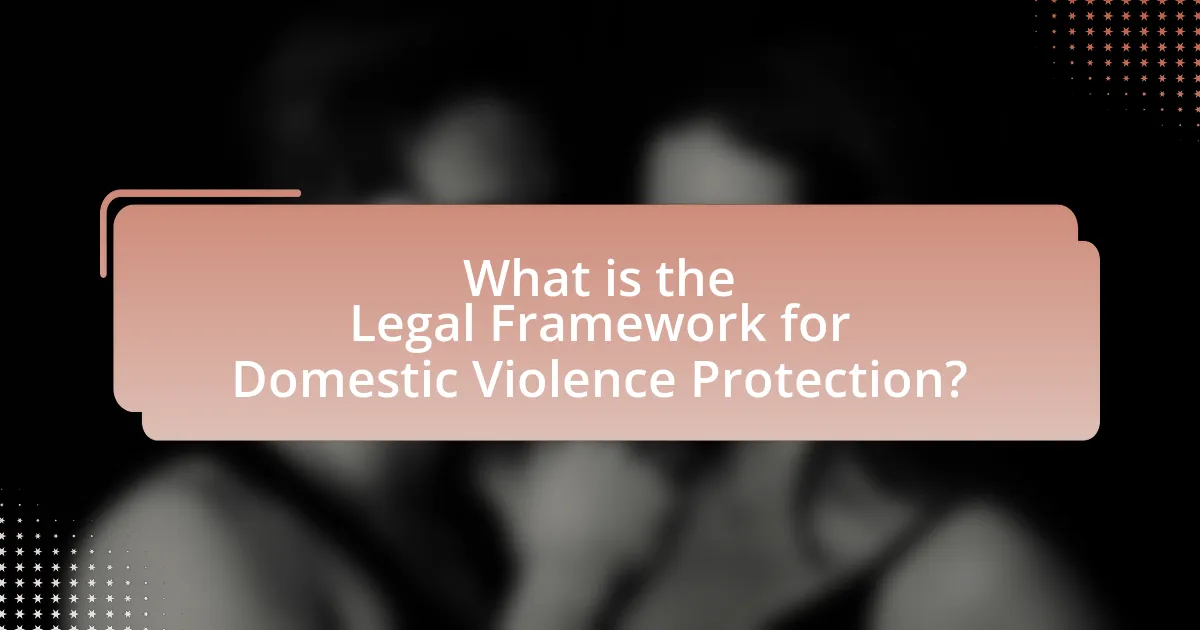
What is the Legal Framework for Domestic Violence Protection?
The legal framework for domestic violence protection consists of laws and regulations designed to prevent and address domestic violence incidents. In the United States, this framework includes federal laws such as the Violence Against Women Act (VAWA), which provides funding for victim services and establishes legal protections for survivors. Additionally, each state has its own specific laws that define domestic violence, outline protective orders, and establish penalties for offenders. For example, many states allow victims to obtain restraining orders, which legally prohibit the abuser from contacting or approaching the victim. These laws are supported by various organizations and resources aimed at assisting victims, ensuring that they have access to legal recourse and support services.
How do different states define domestic violence?
Different states define domestic violence through varying legal frameworks that typically include physical harm, emotional abuse, and threats among intimate partners or family members. For instance, California’s definition encompasses physical injury, sexual assault, and stalking, while Texas includes acts that cause bodily injury, threats, and coercive behavior. These definitions are codified in state laws, such as California Family Code Section 6203 and Texas Family Code Section 71.004, which provide specific criteria for what constitutes domestic violence, reflecting the states’ approaches to protecting victims and prosecuting offenders.
What legal terms are commonly used in state definitions?
Legal terms commonly used in state definitions include “domestic violence,” “abuse,” “victim,” “perpetrator,” “protection order,” and “stalking.” These terms are essential for establishing the legal framework surrounding domestic violence protection. For instance, “domestic violence” typically refers to physical, emotional, or psychological harm inflicted by one intimate partner on another, while “abuse” encompasses various forms of mistreatment. “Victim” identifies the individual experiencing harm, and “perpetrator” denotes the individual committing the act of violence. “Protection order” is a legal mechanism that restricts the perpetrator’s actions to safeguard the victim, and “stalking” refers to repeated, unwanted attention that causes fear or distress. These definitions are critical for understanding and enforcing laws related to domestic violence across different states.
How do definitions vary between states?
Definitions of domestic violence vary significantly between states, as each state has its own legal framework and criteria for what constitutes domestic violence. For instance, some states define domestic violence to include physical harm, while others may encompass emotional abuse, economic control, or stalking. According to the National Coalition Against Domestic Violence, states like California include a broad definition that covers various forms of abuse, whereas states such as Texas have a more narrow focus primarily on physical violence. This variation can affect the availability of protective orders and the resources provided to victims, highlighting the importance of understanding local laws for effective legal protection.
What are the primary laws governing domestic violence protection?
The primary laws governing domestic violence protection include the Violence Against Women Act (VAWA), state-specific domestic violence statutes, and protective order laws. VAWA, enacted in 1994 and reauthorized multiple times, provides federal funding for the investigation and prosecution of domestic violence cases and supports victims through various services. State-specific domestic violence laws vary but generally define domestic violence, establish penalties, and outline victim rights. Protective order laws allow victims to seek court orders to prevent further abuse, with many states offering expedited processes for obtaining these orders. These laws collectively aim to provide a legal framework for the protection and support of domestic violence victims across the United States.
What federal laws impact state domestic violence legislation?
Federal laws that impact state domestic violence legislation include the Violence Against Women Act (VAWA), the Gun Control Act, and the Family Violence Prevention and Services Act (FVPSA). VAWA, enacted in 1994 and reauthorized multiple times, provides federal funding for the investigation and prosecution of violent crimes against women and establishes legal protections for victims. The Gun Control Act prohibits individuals convicted of domestic violence misdemeanors from purchasing firearms, thereby influencing state laws regarding gun ownership for offenders. FVPSA supports the provision of shelter and services for victims of domestic violence, impacting state-level funding and resources for domestic violence programs. These federal laws create a framework that states must consider when developing their own domestic violence legislation.
How do state laws differ in terms of enforcement mechanisms?
State laws differ in terms of enforcement mechanisms primarily through variations in the authority and processes designated for law enforcement and judicial systems to respond to domestic violence cases. For instance, some states empower police officers to make arrests without a warrant if they have probable cause to believe that domestic violence has occurred, while others require a victim to file a complaint first. Additionally, states may differ in the availability and enforcement of protective orders; some states allow for immediate temporary orders that law enforcement must enforce, while others have more complex procedures that can delay enforcement. These differences can significantly impact the effectiveness of domestic violence protections, as evidenced by studies showing that states with more proactive enforcement mechanisms report higher rates of victim safety and lower rates of repeat offenses.
What types of protective orders are available in different states?
Different states offer various types of protective orders, primarily including temporary restraining orders, permanent restraining orders, and emergency protective orders. Temporary restraining orders provide immediate protection and are often issued without the presence of the alleged abuser, while permanent restraining orders require a court hearing and can last for years. Emergency protective orders are typically short-term measures granted in urgent situations, often lasting only a few days. Each state has specific procedures and criteria for obtaining these orders, reflecting the legal framework for domestic violence protection tailored to local laws and regulations.
What are the criteria for obtaining a protective order?
To obtain a protective order, an individual must demonstrate a credible threat of harm or actual violence from another person. This typically involves providing evidence of domestic violence, stalking, harassment, or threats that create a reasonable fear for personal safety. Courts often require documentation such as police reports, medical records, or witness statements to substantiate claims of abuse or threats. In many jurisdictions, the applicant must also show that they have a relationship with the respondent, such as being a spouse, former spouse, or intimate partner, to qualify for a protective order.
How long do protective orders last in various states?
Protective orders vary in duration across different states, typically lasting from a few days to several years. For instance, in California, a temporary restraining order can last up to 21 days, while a permanent restraining order may last up to five years. In New York, an order of protection can last for the duration of the case or up to two years for misdemeanor offenses and five years for felony offenses. In Texas, protective orders can last for up to two years, but they may be extended if necessary. Each state has specific laws governing the duration of protective orders, reflecting the legal framework for domestic violence protection.
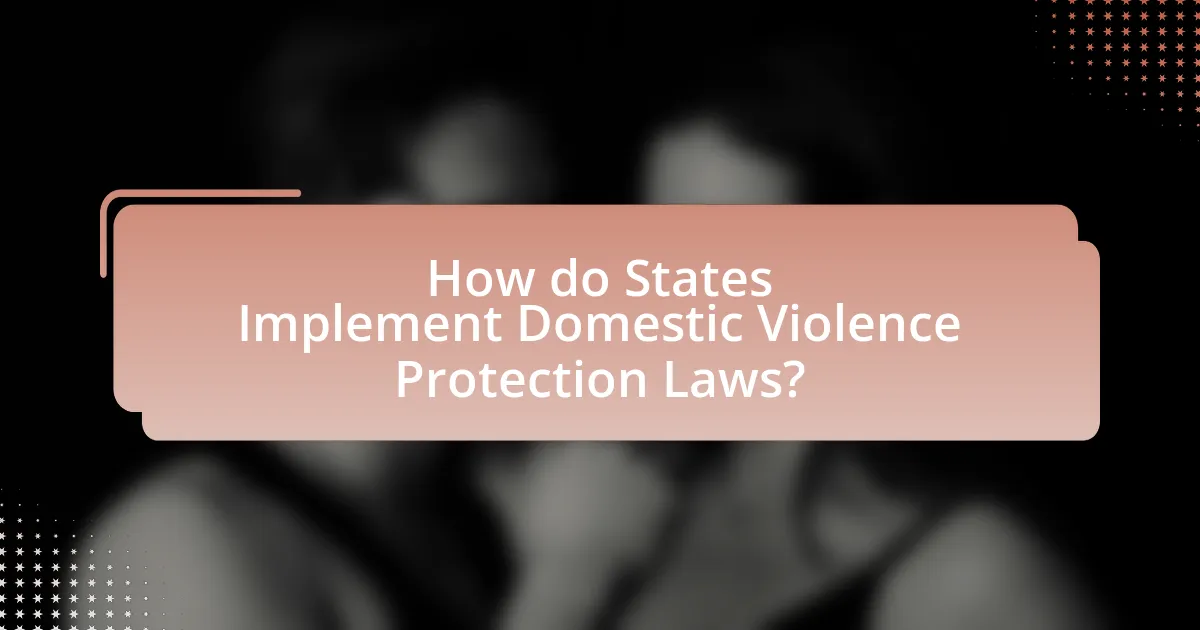
How do States Implement Domestic Violence Protection Laws?
States implement domestic violence protection laws through a combination of legislative measures, law enforcement protocols, and judicial processes. Each state enacts specific statutes that define domestic violence, establish protective orders, and outline penalties for offenders. For example, many states provide for temporary restraining orders that can be issued quickly to protect victims, often allowing law enforcement to intervene immediately. Additionally, states may require law enforcement agencies to undergo training on domestic violence issues to ensure proper handling of cases. According to the National Coalition Against Domestic Violence, as of 2020, all 50 states have laws that allow for the issuance of protective orders, demonstrating a unified legal framework aimed at addressing domestic violence.
What resources are available for victims of domestic violence?
Victims of domestic violence have access to various resources, including hotlines, shelters, legal assistance, and counseling services. National hotlines, such as the National Domestic Violence Hotline, provide 24/7 support and can connect victims to local services. Shelters offer safe housing and support services, while legal assistance can help victims navigate restraining orders and other legal protections. Counseling services provide emotional support and coping strategies. According to the National Coalition Against Domestic Violence, approximately 1 in 4 women and 1 in 9 men experience severe intimate partner physical violence, highlighting the importance of these resources for those in need.
How do shelters and support services vary by state?
Shelters and support services for domestic violence victims vary significantly by state due to differences in funding, legal frameworks, and available resources. For example, states like California and New York have extensive funding for shelters and comprehensive support services, including legal assistance and counseling, while states such as South Dakota and Wyoming may have fewer resources and limited shelter availability. According to the National Network to End Domestic Violence, in 2020, 70% of requests for services went unmet due to lack of resources, highlighting the disparities across states. Additionally, state laws influence the accessibility and types of services offered, with some states mandating specific support services while others do not.
What role do law enforcement agencies play in protecting victims?
Law enforcement agencies play a critical role in protecting victims by enforcing laws, responding to incidents, and providing support services. They are responsible for investigating crimes, apprehending offenders, and ensuring the safety of victims through measures such as issuing protective orders and facilitating access to resources like shelters and counseling. According to the Bureau of Justice Statistics, in 2019, law enforcement agencies made approximately 1.3 million arrests for domestic violence-related offenses, highlighting their active involvement in addressing such cases. Additionally, many agencies have specialized units trained to handle domestic violence situations, which enhances their effectiveness in protecting victims.
How do states handle violations of protective orders?
States handle violations of protective orders through various legal mechanisms, including arrest, fines, and potential jail time for the violator. When a protective order is violated, law enforcement agencies are typically authorized to arrest the individual without a warrant if they have probable cause to believe a violation occurred. Many states classify the violation as a criminal offense, which can result in misdemeanor or felony charges depending on the severity and circumstances of the violation. For instance, according to the National Center for State Courts, states like California impose specific penalties that can include up to one year in jail for misdemeanor violations and longer sentences for felony violations. Additionally, courts may impose civil penalties, such as fines or modifications to the existing protective order, to reinforce compliance.
What penalties exist for violating a protective order?
Violating a protective order can result in various penalties, including criminal charges, fines, and imprisonment. In many jurisdictions, a violation is classified as a misdemeanor, which may lead to fines ranging from $500 to $1,000 and potential jail time of up to one year. In some cases, particularly if the violation involves further threats or acts of violence, it can be elevated to a felony, resulting in more severe penalties, including longer prison sentences and higher fines. For instance, in California, violating a protective order can lead to up to three years in state prison if it is deemed a felony. These penalties are designed to enforce compliance with protective orders and ensure the safety of individuals at risk of domestic violence.
How do states ensure compliance with protective orders?
States ensure compliance with protective orders through a combination of legal enforcement mechanisms, monitoring systems, and penalties for violations. Law enforcement agencies are typically responsible for enforcing these orders, which can include arresting individuals who violate the terms of the order. Additionally, many states have established systems for tracking protective orders, ensuring that they are entered into databases accessible by law enforcement. For instance, the National Crime Information Center (NCIC) maintains a database that includes protective orders, allowing officers to verify their existence during encounters. Furthermore, states impose legal consequences for violations, such as fines or imprisonment, which serve as deterrents. These measures collectively aim to uphold the integrity of protective orders and provide safety for individuals at risk of domestic violence.
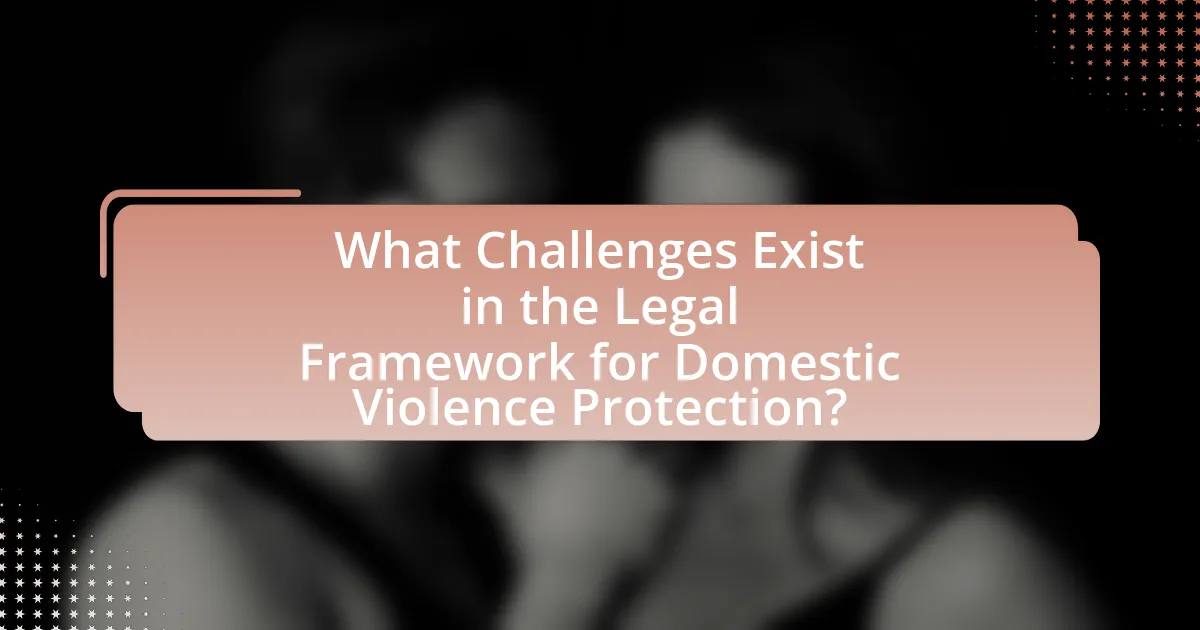
What Challenges Exist in the Legal Framework for Domestic Violence Protection?
The legal framework for domestic violence protection faces several challenges, including inconsistent laws across states, inadequate enforcement of existing protections, and barriers to accessing legal resources. Inconsistency arises because each state has different definitions of domestic violence and varying procedures for obtaining protective orders, which can confuse victims seeking help. Additionally, law enforcement agencies may lack training or resources to effectively enforce protective orders, leading to a lack of accountability for perpetrators. Barriers such as financial constraints, lack of legal representation, and fear of retaliation further hinder victims from navigating the legal system. These challenges contribute to the overall ineffectiveness of legal protections for domestic violence victims.
What barriers do victims face when seeking legal protection?
Victims face several barriers when seeking legal protection, including fear of retaliation, lack of awareness of legal rights, and inadequate access to legal resources. Fear of retaliation can deter victims from pursuing legal action, as they may worry about further violence or harassment from the abuser. Additionally, many victims are unaware of the protections available to them under the law, which can prevent them from taking necessary steps to secure their safety. Furthermore, limited access to legal resources, such as financial constraints or lack of legal representation, can hinder victims’ ability to navigate the legal system effectively. According to a report by the National Domestic Violence Hotline, 71% of victims cited fear of the abuser as a significant barrier to seeking help, highlighting the pervasive impact of intimidation on victims’ willingness to pursue legal protection.
How does socioeconomic status affect access to legal resources?
Socioeconomic status significantly affects access to legal resources by creating disparities in the ability to afford legal representation and navigate the legal system. Individuals with higher socioeconomic status typically have greater financial means to hire attorneys, access legal advice, and utilize support services, while those with lower socioeconomic status often face barriers such as cost, lack of information, and limited availability of free or low-cost legal aid. For instance, a study by the Legal Services Corporation found that 86% of low-income Americans receive inadequate or no legal help for essential civil legal problems, highlighting the stark contrast in access based on socioeconomic factors.
What role does cultural stigma play in reporting domestic violence?
Cultural stigma significantly hinders the reporting of domestic violence by instilling fear and shame in victims. This stigma often leads individuals to believe that they will not be believed, judged, or ostracized by their community if they come forward. Research indicates that in cultures where domestic violence is normalized or minimized, victims are less likely to seek help; for instance, a study published in the Journal of Interpersonal Violence found that cultural beliefs about gender roles and family honor directly correlate with underreporting of domestic violence incidents. Thus, cultural stigma creates an environment where victims feel isolated and unsupported, ultimately discouraging them from reporting abuse.
How effective are current laws in protecting victims?
Current laws are moderately effective in protecting victims of domestic violence, but their effectiveness varies significantly by state. For instance, states with comprehensive protective orders and mandatory arrest laws tend to provide better protection, as evidenced by a study from the National Institute of Justice, which found that states with such laws report lower rates of repeat victimization. However, gaps remain in enforcement and accessibility, with many victims facing barriers such as lack of legal representation and inadequate law enforcement response. This inconsistency highlights the need for ongoing reform and better implementation of existing laws to enhance victim protection across all states.
What statistics exist on the success rates of protective orders?
Statistics indicate that protective orders have varying success rates, with studies showing that approximately 70% of individuals who obtain a protective order report feeling safer afterward. Research published in the “Journal of Interpersonal Violence” found that about 50% of protective orders are violated, but the presence of a protective order can reduce the likelihood of future violence. Additionally, a study by the National Center for State Courts revealed that protective orders are more effective when combined with other support services, leading to improved outcomes for victims.
How do state resources impact the effectiveness of domestic violence laws?
State resources significantly impact the effectiveness of domestic violence laws by determining the availability of funding, personnel, and support services for enforcement and victim assistance. Adequate resources enable law enforcement agencies to receive training on domestic violence issues, ensuring that officers can respond appropriately and sensitively to incidents. For instance, states with dedicated funding for domestic violence programs often report higher rates of victim support and lower rates of recidivism among offenders. Additionally, research from the National Institute of Justice indicates that jurisdictions with robust resource allocation for domestic violence initiatives see improved legal outcomes, such as increased prosecution rates and successful convictions. Thus, the level of state resources directly correlates with the practical implementation and overall success of domestic violence laws.
What best practices can improve domestic violence protection laws?
Best practices to improve domestic violence protection laws include implementing mandatory reporting requirements for healthcare and social service professionals, enhancing training for law enforcement on trauma-informed responses, and establishing clear legal definitions of domestic violence that encompass various forms of abuse. Mandatory reporting ensures that incidents are documented and addressed promptly, which can lead to better outcomes for victims. Training law enforcement in trauma-informed approaches helps officers respond sensitively and effectively, reducing the likelihood of re-traumatization. Clear legal definitions help in the consistent application of laws and ensure that all forms of abuse, including emotional and financial, are recognized and prosecuted. These practices are supported by research indicating that comprehensive legal frameworks and informed responses significantly improve victim safety and access to resources.
How can states enhance victim support services?
States can enhance victim support services by increasing funding for comprehensive programs that provide legal, psychological, and financial assistance to victims of domestic violence. Research indicates that states with dedicated funding for victim services see improved outcomes for survivors, including higher rates of reporting and access to necessary resources. For example, the Violence Against Women Act (VAWA) has allocated billions in federal funding to support state-level initiatives, demonstrating the effectiveness of financial investment in victim support services. Additionally, states can implement training programs for law enforcement and service providers to ensure they are equipped to respond sensitively and effectively to victims’ needs, further improving the overall support system.
What legislative changes could strengthen domestic violence protections?
Legislative changes that could strengthen domestic violence protections include implementing mandatory reporting laws for healthcare professionals and expanding access to protective orders. Mandatory reporting laws would require healthcare providers to report suspected cases of domestic violence, ensuring that victims receive timely support and intervention. Expanding access to protective orders would allow victims to obtain legal protection more easily, including provisions for temporary custody of children and financial support. Research indicates that states with more accessible protective order processes see a decrease in domestic violence incidents, highlighting the effectiveness of such legislative measures.
